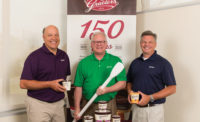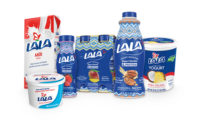Life is a bowl of Perry’s. Visitors to Perry’s Ice Cream’s (Perry’s) Akron, N.Y.-based headquarters and processing facility are sure to spot that particular saying across signage, corporate literature and even product packaging.
To live up to that clever play on words, the company, which is celebrating its 100th anniversary this year, still creates its ice cream using the same old-fashioned recipe and methods that founder H. Morton Perry handed down decades ago. These days, it simply is creating a heck of a lot more of it. Measured in servings, production is roughly a half-million units a day.
“That’s over 500,000 happy people enjoying our delicious ice cream 365 days of the year,” said Joel Bearfield, Perry’s vice president of operations.
In terms of capacity, the ice cream plant is capable of producing 57,600 sqrounds, 76,800 pints, 31,680 quarts and 6,720 3-gallon/2.5-gallon tubs of ice cream, sherbet, sorbet and frozen yogurt daily. In addition, it can crank out 153,600 stick novelties and 184,000 ice cream sandwiches, Bearfield noted.
Commissioned in 1982, the 120,000-square-foot facility was first expanded in 1984, then again in 1987. In 1997, an employee cafeteria and the corporate offices were added to the structure, and in 2008, a new 18,000-square-foot freezer was unveiled. The manufacturing operations currently employ 137 people across three shifts — the first and third for production, the second for sanitation.
Maximizing flavor via small batches
Production begins with the arrival of fresh milk, cream and condensed skim/buttermilk, as well as liquid sugars, to the facility during first-shift operations (roughly 20 truckloads per week). All of the milk is sourced from farms within a 100-mile radius of the plant, Bearfield said.
Other delivered ingredients, as well as packaging materials, are stored either in Perry’s on-site dry warehouse or at a local storage facility.
“We utilize just-in-time inventory and follow a first-in/first-out policy,” Bearfield said.
Inclusions and ingredients requiring refrigeration go to a “40-degree room” located in the on-site warehouse, he added. The room is also used to defrost frozen ingredients. On-site “hot rooms,” meanwhile, are used for tempering variegates to their specified use temperature. Inventory is color-coded and stored according to allergen.
After initial testing, the milk, cream and condensed skim and buttermilk are pumped into the raw storage tanks. From there, the liquid dairy product, dry ingredients and liquid sugars are blended in one of two 800-gallon tanks before being transferred to a plate-frame high-temperature short-time pasteurizer and homogenizer. For the Perry’s brand exclusively, the plant holds the pasteurized mix for 30 minutes to “vat pasteurize.”
“We make it in small batches, one batch at a time — the original way,” Bearfield said. “It’s a slow process that brings out a full flavor.”
Frozen yogurt mix has its own dedicated tanks, Bearfield noted.
After pasteurization and homogenization, the mix is cooled down and pumped to one of 15 pasteurized holding tanks before smaller quantities of mix are pulled into one of 22 numbered flavor vats. Team members add flavors and bases here — the plant relies on 90 different base mixes to create more than 500 ice cream varieties.
The mix passes through freezer barrels, where air is incorporated as the mix is frozen. Inclusions and variegates are then added through fruit feeders and/or pumps to the frozen mix. Five different lines are each dedicated to a different size or type of product.
“One of the five lines makes stick novelties,” Bearfield explained. “The mix enters three barrel freezers in a liquid state and exits into the filler in a soft-serve state.”
The plant relies on two molds for stick products — fluted and paddles, he added. After the molds are filled, a stick is automatically added to each. Some products then get a dip in liquid chocolate before being wrapped. Team members hand-pack the finished novelties in cartons before they are conveyed to the frozen warehouse.
The bulk ice cream line, meanwhile, is dedicated to 3-gallon and 2.5-gallon containers for foodservice and scoop shop customers.
“The mix passes through an in-line metal detector,” Bearfield said. “An operator makes the containers just prior to filling. The operator tops the filled containers with a parchment paper seal and lid, [and they] then proceed to the hardener.”
The remaining lines handle Perry’s pints, quarts, 48-ounce sqrounds and sandwiches. Before the packaged sqrounds are bundled in the packaging center (four to a bundle), they are then sent through a state-of-the-art vision system that checks that the containers and lids match.
“Running our sqrounds through a vision system greatly reduces the likelihood of a product recall, due to a packaging error,” Brian Perry, executive vice president and chair of the company, said of that technology.
After bundling, the ice cream is sent to the hardener, set at -30 degrees Fahrenheit with a wind chill of -60 degrees Fahrenheit. The product hardens for four hours before a truck transports it to the company’s frozen warehouse.
Managing allergens — and more
With five lines running concurrently, the facility already boasts a high level of complexity. And the planning involved with production scheduling only adds to that complexity. After all, the plant uses ingredients containing six of the eight major allergens.
“Perry’s schedules production based on the flavors and ingredients to be used in order to minimize changeovers and to reduce the possibility of cross-contamination,” Bearfield noted. “For example, Perry’s might first run a batch of chocolate ice cream and then change over to production of a chocolate Panda Paws — containing peanut butter — but not the other way around.”
Food safety efforts go far beyond allergen management, however. The plant is Safe Quality Food (SQF) program certified and has maintained an Excellent rating since its first audit, Bearfield said. The SQF program emphasizes the systematic application of hazard analysis and critical control points (HACCP).
“We have an active cross-functional HACCP team, and most of them have received formal HACCP training,” Bearfield said. “This team meets monthly and reviews topics such as changes to equipment, new ingredients, new products, the environmental program, the allergen programs and recent plant audits.”
And many members of the plant’s operations leadership team are certified SQF practitioners, he added. One of these members serves as the quality assurance coordinator, monitoring the SQF program and policies daily to ensure compliance. In addition, several team members are certified as preventive controls-qualified individuals to comply with the Food Safety and Modernization Act.
Perry’s on-site laboratory is certified, too, and its technicians are licensed by the New York State Department of Agriculture and Markets, Bearfield said. In addition to testing product for butterfat, total solids, bacteria and allergens, the technicians work closely with other team members to verify the cleanliness of equipment and the safety and quality of the products produced.
“Equipment is inspected, and we utilize ATP [adenosine triphosphate] to verify cleaning effectiveness,” he noted. “Quality assurance and sanitation also collaborate on the environmental monitoring program. Results are evaluated as a team, and the sample locations are under constant review.”
To keep food safety and quality top of mind with all team members, the plant engages in mock recalls, Bearfield added, as well as good manufacturing practices training and allergen training. Cross-functional teams, meanwhile, conduct internal plant audits.
“Audit results are shared with the teams so they can continue to strengthen programs in their areas,” he said.
Suppliers also get scrutinized in the name of food safety and quality. Perry’s has a vendor certification program that requires existing and potential vendors to submit specific documents so the company can perform a risk assessment, Bearfield said.
“New ingredients also go through a risk assessment and require HACCP team approval prior to use,” he added.
Finished product is subject to line sampling that starts at the beginning of production of each flavor and continues throughout the production run. Both production and quality assurance team members are tasked with the sampling, Bearfield noted.
“They ensure that the weights and code dates are correct, as well as [perform] a swipe test that ensures that inclusions and sauces are evenly distributed throughout the container,” he said. “Our quality assurance team also performs a sensory test to ensure that the product tastes great just like it always should.”
And once product is transported to the freezer, it is put on a quality assurance hold, Bearfield explained. The lab requires approximately 24 hours to complete the necessary microbiological and allergen testing before releasing the products for distribution.
Protecting, championing team members
From the beginning, H. Morton Perry’s mantra was: “Make sure you put in enough of the good stuff.” That “good stuff” referred not only to the highest-quality product, but also to top-notch service and personnel. (See “100 Years of the Good Stuff”)
Perry’s continues to adhere to its founder’s mantra, and it recognizes that plant team members are a crucial part of that good stuff. So worker safety is top of mind.
Perry’s works hard to involve all plant-level team members in plant safety efforts, Bearfield said.
“Safety is No. 1 at Perry’s Ice Cream,” he emphasized. “We comply with all Occupational Safety and Health standards, as well as other federal, local and municipality regulations. … Our maintenance technicians are all Level A HAZMAT technicians, and we have a mobile HAZMAT team,” he added.
The company relies on a combination of internal training, third-party training and seminars to meet those regulations, Bearfield said. And to reduce fatigue and repetitive motion, Perry’s cross-trains its team members on various equipment.
“For example, many of our packers and operators are cross-trained to run all five production lines,” he said. “This flexibility is also key for covering vacation [and] sick and personal time off.”
Perry’s also aims to help team members grow in their careers. So the company looks to hire the right people from the start.
“We are always looking for people with a solid work history, dedication and a passion for ‘doing what’s right,’” Bearfield stressed. “We are a family business, and we want it to feel like family while at work.”
Typically, a new team member starts off in a packer or distribution position, he noted. Perry’s then provides an opportunity for that team member to work his or her way up into a higher-paying position such as an operator or another role that comes with increased responsibilities such as cleaning and sanitizing equipment.
Embracing technology
Technology also plays a huge role in Perry’s ability to deliver enough of the good stuff to customers and consumers. At the plant level, the company spends “a substantial amount of capital” each year in the name of food and team member safety, as well as for “mission critical” efforts such as engine room control and motor control center updates, Bearfield explained.
“We continue to invest capital within the facility to reduce waste, improve overall operating efficiency and [be] good stewards of our community and the environment,” he said.
Among the many innovative technologies in place at the world-class plant are a new process logic control system in the engine room that enables monitoring of a wide range of compressor and ammonia system data; an operation equipment effectiveness (OEE) software system that allows team members to track line availability, performance, discrete yield, changeovers and downtime; upgraded metal detectors and checkweighers; and the aforementioned vision system, Bearfield noted.
And a few years ago, Perry’s invested in pick-to-voice technology for the warehouse, added Gayle Perry Denning, the company’s vice president of sustainability and strategic branding.
“It’s the way that younger people want to work,” she said. “They don’t want a clipboard; they’re expecting technology.”
And more technology updates are in the works. For example, Perry’s information technology team is currently implementing a weigh tracking system linked to the enterprise resource planning/material resource planning and OEE systems, Bearfield said. It also is in the process of replacing two of its lines with fillers that will not only double capacity, but also slash downtime and waste.
“As we are developing some of the newer niche health products, as well as handling more and more allergens, we will be investing in segregated line circuits, cleaning systems and dedicated tanks,” he added.
Some of the updates reflect the shift in customer needs from just “big and fast” to more “customization and variety,” Bearfield suggested.
“We now need to be fast, fluid and flexible — and very efficient with changeovers from one product to another,” he said.










